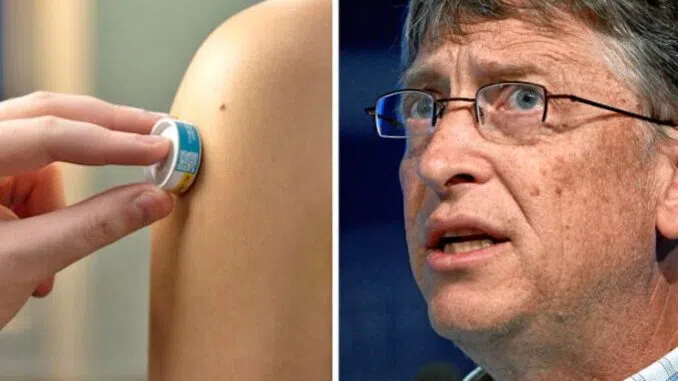The new mRNA vaccination technique that utilizes patches instead of needles has been presented by Bill Gates. Gates is hoping that governments would require those with lower incomes to wear the patches.
Vaccine-containing microarray patches (VMAP), also known as “micro-array patches” or “microneedle patches,” have been the focus of hundreds of scholarly studies over the course of the past several years. These patches have been supported financially by the Bill & Melinda Gates Foundation, the World Health Organization (WHO), and Gavi. What could possibly go wrong?
Gates believes that the mRNA patches will solve the problem of vaccination reluctance in developing nations that do not have the financial means to pay for conventional needle-based immunizations.
The scientific and medical professionals who were questioned by The Defender highlighted concerns and questions regarding the technology, as well as possible risks associated with it.
According to Barbara Loe Fisher, co-founder of the National Vaccine Information Center, current president of the organization, and co-author of the book “DPT: A Shot in the Dark,” which was published in 1985, the following was stated to The Defender:
“A VMAP is a biological product that, regardless of how it is administered—through a needle or a patch—unusually manipulates the immune system in order to elicit intense inflammatory reactions. These responses, in turn, can cause harm or even death in some people who receive the VMAP.
“If you look at the medical literature describing microneedle vaccine patches, what you see is a lot of hype about how much easier it will be for the vaccinators to slap a patch on a child’s skin instead of using a needle, and how the ‘painless’ patch can reduce vaccine hesitancy,” said the author of the article.
According to Fisher, reluctance toward vaccination “has never been about how the product is delivered.” On the contrary, “it has always been about the lack of evidence demonstrating safety.”
According to Children’s Health Defense’s senior director of science and research Brian Hooker, Ph.D., P.E., the phrase “vaccine patch” may also be deceptive because it may be mistaken for nicotine patches for smokers.
Hooker told The Defender:
“The term ‘vaccine patch’ is misleading in that this microarray technology is not at all like other patch-based delivery systems for nicotine or hormones,” said the researcher. This “patch” still needs to make an incision in the skin in order to deliver the liquid vaccine that is embedded inside the matrix of the microarray.
“As a result of this, I am not quite certain how this injectable device would be provided to patients and parents so that they may directly give the vaccination. That appears to be pretty hazardous.
“Unfortunately, repackaging the same vaccines in this different platform does nothing to improve the safety of the vaccines, as this appears to be more of a ploy to convince consumers otherwise.”
Those who support the VMAP want to “turn vaccines into vaccinations.”
According to an article that was released by Gavi the week before last, VMAPs can “overcome many obstacles and bottlenecks faced by intradermal vaccine delivery, thus maximizing the reach of vaccines to the most remote locations to turn vaccines into vaccination.”
According to UNICEF, “VMAPs can increase vaccine coverage by increasing acceptability by caregivers and recipients, and administering vaccines more rapidly and easily with minimally trained health care workers.” Additionally, “VMAPs can substantially improve the productivity and resilience of governments to expand immunization coverage.”
The viewpoint taken by UNICEF is identical to that taken by the World Health Organization, the Gates Foundation, and the Clinton Health Access Initiative (together referred to as “The Big Catch-up”). “The Big Catch-up” is being referred to as “the largest childhood immunization effort ever,” and its goal is to reverse “declines in childhood vaccination recorded in over 100 countries since the pandemic.”
The UN Children’s Fund (UNICEF) has said that it is “focusing on driving the research, development, and scale of VMAPs,” which includes “identifying barriers for scaling and investigating the need for market pull incentives to spark interest and endorsement by vaccine manufacturers.”
Nevertheless, no VMAPs have yet been approved by regulators, according to Gavi, which states that, at present, “one measles and rubella vaccine patch has completed Phase 1/2 clinical trials. Two further clinical studies spanning phases 1/2 are scheduled to take place.
“Some COVID-19 and flu vaccines are also entering Phase 1/2 trials,” Gavi said, adding that additional vaccinations, such as HPV, are undergoing preclinical evaluation.
Data from Phases 1 and 2 of the first-ever clinical study of VMAPs in children was released in May during the Microneedles 2023 conference in Seattle, and it reportedly yielded “promising results.” This information was provided by Gavi.
“evaluated the safety, immunogenicity, and acceptability” of an MR vaccine given by micro-array technology created by Atlanta-based Micron Biomedical. The experiment was carried out in Gambia with 45 adults, 120 toddlers 15-18 months of age, and 120 babies 9-10 months of age.
The Serum Institute of India, which is the largest vaccine maker in the world in terms of the number of doses manufactured and sold, was the one responsible for developing the vaccine. Over half of all vaccinations that are given to infants across the world are produced by the Serum Institute, which is responsible for producing the COVISHIELD COVID-19 vaccine.
In India, family members of deceased vaccine damage victims have launched two separate lawsuits against the Serum Institute, as well as against Bill Gates, naming both of them as defendants in the cases.
Imagining a world in which individuals would be able to get vaccination patches delivered to their homes through the mail.
The advocates of VMAPs have continued to assert that the use of this technology would result in a wide variety of positive outcomes despite the absence of any clinical tests that have been finished satisfactorily.
According to Gavi, VMAPs are “needle-free and pre-dosed,” which simplifies the administration of vaccinations, which may then “be carried out by minimally trained volunteers.” VMAPs also reduce the risk of adverse reactions to immunizations.
In addition to this, Gavi asserts that VMAPs “are safer as they overcome the risks related to operational errors” that might occur during administration, such as incorrect dosages and injuries caused by needle sticks.
According to Gavi, VMAPs are “easier to distribute” because of their small weight and “enhanced thermostability.” This tackles “the problem of vaccine storage requirements” and eliminates “the need for cold chains.” Additionally, VMAPs do not require refrigeration.
Moreover, Gavi claims “The lower level of pain experienced during administration with MAPs would help reduce vaccine hesitancy and increase vaccine acceptability.”
“There are issues in reaching the last mile with the current injectable vaccinations since they are dependent on a working cold-chain and delivery by well-trained employees… In addition, the majority of vaccinations are delivered through injection, which may be painful and uncomfortable, which might lead to reluctance, according to UNICEF.
According to a report published by Avalere, a healthcare consulting firm, VMAPs offer “the potential for lower healthcare costs,” “increased compliance due to convenient and pain-free application,” is “ideal for patients with needlestick phobias or difficulty swallowing,” and are “easier for children, older people, and patients requiring complex care.”
The Center for the Evaluation of Personalized Immunization Strategies (CEPI) suggests that VMAPs “could enable a future in which vaccine patches could be mailed directly to people’s homes, workplaces, and schools, avoiding the delay and inconvenience of traditional needle-and-syringe vaccine scheduling and administration.”
The Center for Epidemic Preparedness Innovations (CEPI) touts itself as “an innovative global partnership between public, private, philanthropic, and civil society organizations launched in Davos in 2017 to develop vaccines to stop future epidemics.”
VMAPs are being considered for use in a diverse array of vaccinations, including mRNA injections.
According to proponents of the VMAP technology, the alleged benefits of this technology can ultimately translate to working as an “advantageous delivery route for existing vaccines,” including influenza, tetanus toxoid, MR, and hepatitis B vaccines, as well as “biologics and small molecules.”
According to the World Health Organization (WHO), a VMAP for the MR vaccine may be “potentially favorable,” with “perceived operational advantages that could ultimately increase equitable coverage and facilitate vaccine administration in inaccessible areas.”
Vaccination coverage for measles and rubella “has stagnated,” according to an article published on January 16 in the journal Frontiers in Public Health. The article states that VMAPs “are anticipated to offer significant programmatic advantages to needle and syringe” options and lead to increased vaccination coverage, with “significant demand expected for MR-MAPs between 2030 and 2040.”
And on January 17, CEPI began conducting preclinical tests for a “high-density microarray patch… to evaluate its potential as a rapid-response technology for heat-stable, dried-formulation mRNA vaccines and to assess its stability, safety, and immunogenicity.”
According to CEPI, this effort was developed out of their request for ideas in January 2022, which was part of its “wider strategic goal of harnessing innovative technologies to improve the speed, scale, and access of vaccine development and manufacturing in response to epidemic and pandemic threats.”
Proponents of the VMAP have connections to Bill Gates, the World Bank, and the World Economic Forum.
While Gavi states that “There is a need for investments to fund pilot-scale manufacturing facilities” for VMAPs, Gavi and other entities that are actively promoting this technology are themselves backed by or connected to some of the most prominent investors in the world, as well as major global organizations. Gavi also states that “There is a need for investments to fund pilot-scale manufacturing facilities” for VMAPs.
According to Gavi, the organization “helps vaccinate almost half of the world’s children against deadly and debilitating infectious diseases.” It was established in 1999, with the Gates Foundation as one of its co-founders and one of its four permanent board members.
In addition to its key partnerships with UNICEF, the World Bank, and the World Health Organization (WHO), which includes Gavi in its list of “relevant stakeholders,” the Rockefeller Foundation is also a partner, board member, and donor to Gavi. Gavi’s mission is to eliminate preventable deaths caused by vaccine-preventable diseases.
PATH’s President and Chief Executive Officer, Nikolaj Gilbert, is a member of Challenge Seattle, which is defined as “an alliance of CEOs from Seattle area’s largest employers including Microsoft, the Bill & Melinda Gates Foundation, Starbucks, and Boeing.” Gilbert has links to the Gates family and the Bill & Melinda Gates Foundation. He once held the position of director for the multinational pharmaceutical company Novo Nordisk.
According to the annual report of PATH for 2021, the organization receives funding from a variety of sources, some of which include the Gates Foundation, the Schwab Charitable Fund, and the Vanguard Charitable Endowment. Other sources of funding include the United Nations, Gavi, the Centers for Disease Control and Prevention, the World Bank, and the World Health Organization.
PATH has also received funding from the Gates Foundation, the Rockefeller Foundation, Google, and the World Bank for vaccine projects in countries such as India.
Together with the Wellcome Trust and the World Economic Forum (WEF), the Bill & Melinda Gates Foundation was one of the organizations that established CEPI. In point of fact, the World Economic Forum’s annual conference is held in Davos, Switzerland, which is also the location of the founding of CEPI. Dr. Richard J. Hatchett, the company’s current Chief Executive Officer, formerly served as interim director of the United States Biomedical Advanced Research and Development Authority.
There are several connections between CEPI board members and other organizations, such as the Gates Foundation.
For instance, Dr. Anita Zaidi is the president of gender equality, director of vaccine development and surveillance, and director of enteric and diarrheal diseases programs at the Gates Foundation, while non-voting member Gagandeep “Cherry” Kang, M.D., Ph.D., is chair of the foundation’s Joint Working Group.
Dr. Juan Pablo Uribe is a member of the World Bank who does not have voting rights, but he serves as the global director for health, nutrition, and population as well as the head of the global financing facility for women, children, and adolescents.
Through his involvement in WHO briefings during the COVID-19 epidemic, Dr. Mike Ryan, who is also a non-voting member, rose to worldwide notoriety and currently serves as the executive director of the Health Emergencies Programme at the World Health Organization (WHO).
And Dr. L. Rizka Andalucia, who is a non-voting member but is the director-general for Pharmaceutical and Medical Devices at Indonesia’s Ministry of Health, also serves on the board. At the G20 conference in Bali in November 2022, the Indonesian Minister of Health Budi Gunadi Sadikin asked for a “digital health certificate acknowledged by the WHO” that would enable the general population to “move around.”










